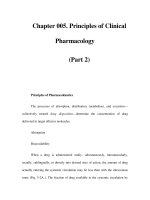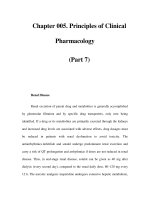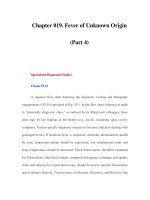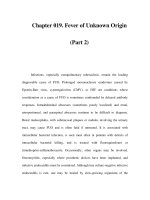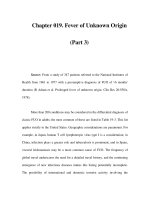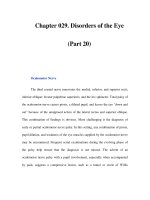Chapter 105. Malignancies of Lymphoid Cells (Part 2) ppt
Bạn đang xem bản rút gọn của tài liệu. Xem và tải ngay bản đầy đủ của tài liệu tại đây (46.49 KB, 5 trang )
Chapter 105. Malignancies of
Lymphoid Cells
(Part 2)
Non-Hodgkin's lymphomas were separated from Hodgkin's disease by
recognition of the Sternberg-Reed cells early in the twentieth century. The
histologic classification for non-Hodgkin's lymphomas has been one of the most
contentious issues in oncology. Imperfect morphologic systems were supplanted
by imperfect immunologic systems, and poor reproducibility of diagnosis has
hampered progress. In 1999, the World Health Organization (WHO) classification
of lymphoid malignancies was devised through a process of consensus
development among international leaders in hematopathology and clinical
oncology. The WHO classification takes into account morphologic, clinical,
immunologic, and genetic information and attempts to divide non-Hodgkin's
lymphomas and other lymphoid malignancies into clinical/pathologic entities that
have clinical and therapeutic relevance. This system is presented in Table 105-3.
This system is clinically relevant and has a higher degree of diagnostic accuracy
than those used previously. The possibilities for subdividing lymphoid
malignancies are extensive. However, Table 105-3 presents in bold those
malignancies that occur in at least 1% of patients. Specific lymphoma subtypes
will be dealt with in more detail below. Lymphomas associated with HIV infection
are discussed in Chap. 182.
Table 105-3 WHO Classification of Lymphoid Malignancies
B Cell T Cell Hodgkin's
Disease
Precursor B cell
neoplasm
Precursor T cell
neoplasm
Nodular
lymphocyte-
predominant
Hodgkin's disease
Precursor B
lymphoblastic
Precursor T
lymphoblastic
leukemia/lymphoma
(precursor B cell acute
lymphoblastic leukemia)
lymphoma/leukemia
(precursor T cell acute
lymphoblastic leukemia)
Mature (peripheral) B
cell neoplasms
Mature (peripheral) T
cell neoplasms
Classical
Hodgkin's disease
B cell chronic
lymphocytic
leukemia/small
lymphocytic lymphoma
T cell prolymphocytic
leukemia
Nodular
sclerosis Hodgkin's
disease
B cell
prolymphocytic leukemia
T cell granul
ar
lymphocytic leukemia
Lymphocyte-
rich classic
Hodgkin's disease
Lymphoplasmacytic
lymphoma
Aggressive NK cell
leukemia
Mixed-
cellularity Hodgkin's
disease
Splenic marginal
Adult T cell
Lymphocyte-
zone B cell lymphoma (±
villous lymphocytes)
lymphoma/leukemia (HTLV-
I+)
depletion Hodgkin's
disease
Hairy cell leukemia
Extranodal NK/T cell
lymphoma, nasal type
Plasma cell
myeloma/plasmacytoma
Enteropathy-
type T
cell lymphoma
Extranodal
marginal zone B cell
lymphoma of MALT type
Hepatosplenic γd T
cell lymphoma
Mantle cell
lymphoma
Subcutaneous
panniculitis-
like T cell
lymphoma
Follicular
lymphoma
Mycosis
fungoides/Sézary syndrome
Nodal marginal zone
Anaplastic l
arge cell
B cell lymphoma (±
monocytoid B cells)
lymphoma, primary cutaneous
type
Diffuse large B cell
lymphoma
Peripheral T cell
lymphoma, not otherwise
specified (NOS)
Burkitt's
lymphoma/Burkitt cell
leukemia
Angioimmunoblastic
T cell lymphoma
Anaplastic large cell
ly
mphoma, primary
systemic type
Note: HTLV, human T cell lymphotropic virus; MALT, mucosa-
associated
lymphoid tissue; NK, natural killer; WHO, World Health Organization.
Malignancies in bold occur in at least 1% of patients.
Source: Adapted from Harris et al.

